

European Theater of Operations - Northern Ireland
by Gary Bedingfield
Northern Ireland England/Scotland Continental Europe
Copyright © 2020 Gary Bedingfield (Baseball
in Wartime). All Rights Reserved.
 It
took just seven weeks following the Japanese attack at Pearl Harbor
for American troops to reach the shores of Northern Ireland. Within
three months more than 10,000 American servicemen would be in
Ireland but this apparently amazing logistical feat had been
carefully planned since April 1941. At that time the War
Department's RAINBOW-5 plan envisioned deployment of 30,000 troops
in Northern Ireland . In reality, the figure would be closer to
50,000. By June 1941, a full six months before America 's entry into
the war, American civilian contractor laborers began construction on
US naval bases. Special Observer Groups of the US Army were also
present in Ireland at that time identifying suitable locations for
airfields, army camps, hospitals and ammunition depots.
It
took just seven weeks following the Japanese attack at Pearl Harbor
for American troops to reach the shores of Northern Ireland. Within
three months more than 10,000 American servicemen would be in
Ireland but this apparently amazing logistical feat had been
carefully planned since April 1941. At that time the War
Department's RAINBOW-5 plan envisioned deployment of 30,000 troops
in Northern Ireland . In reality, the figure would be closer to
50,000. By June 1941, a full six months before America 's entry into
the war, American civilian contractor laborers began construction on
US naval bases. Special Observer Groups of the US Army were also
present in Ireland at that time identifying suitable locations for
airfields, army camps, hospitals and ammunition depots.
The first troops to arrive in Northern Ireland was a contingent of
4,058 men of the 34th Infantry Division on January 26 th 1942. These
proud young men from the Midwestern United States were followed in
May 1942 by the 1st Armored Division from Fort Knox, Kentucky, with
tanks and armored vehicles never before seen in this small part of
the United Kingdom .
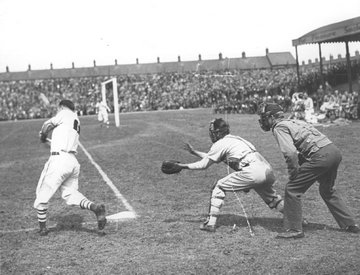 By June 1942 more than 41,205 American military personnel were
stationed in Northern Ireland, and with the Americans came American
culture, from bubble gum and candy to big bands and, of course,
baseball. The build-up was an impressive display of American
efficiency, but one obstacle, unforeseen by military high command,
was causing a dilemma.
By June 1942 more than 41,205 American military personnel were
stationed in Northern Ireland, and with the Americans came American
culture, from bubble gum and candy to big bands and, of course,
baseball. The build-up was an impressive display of American
efficiency, but one obstacle, unforeseen by military high command,
was causing a dilemma.
In a country where similarities with home seemed to end with the
language, troops became desperately homesick. Daily training left
them restless, agitated and suffering low morale. Something was
needed to prevent the worsening of an already difficult situation.
It was evident that a competitive sports program could help improve
matters, and team games of basketball and soccer, combined with
track and boxing, went a long way to make amends. But America 's
national pastime – baseball – had by far the greatest impact on
morale.
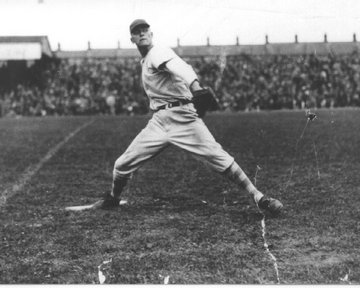 The first recorded baseball game took place near Belfast on
Saturday, April 25, 1942. Despite overcast, blustery conditions, the
2nd and 3rd Battalions of the 133rd Infantry Regiment, 34th Infantry
Division, attracted an inquisitive crowd of more than 1,000 locals
who were treated to a play-by-play account over a public address
system, a concert by the regiment band, and an impromptu jitterbug
demonstration on the sidelines.
The first recorded baseball game took place near Belfast on
Saturday, April 25, 1942. Despite overcast, blustery conditions, the
2nd and 3rd Battalions of the 133rd Infantry Regiment, 34th Infantry
Division, attracted an inquisitive crowd of more than 1,000 locals
who were treated to a play-by-play account over a public address
system, a concert by the regiment band, and an impromptu jitterbug
demonstration on the sidelines.
Major General Russell P Hartle, acting commander of the US Army
Northern Ireland Force (USANIF), was invited to throw out the first
pitch, and with all the fanfare of a major league opening day,
baseball had arrived in Northern Ireland . Pitching for the winning
3rd Battalion in the 14-4 game was Corporal
Robert Lange of Wilton Junction, Iowa , a 21-year-old
right-hander who was a member of the Cleveland Indians' farm system
and had an 8-4 won-loss record with the Flint Arrows of the Michigan
State League in 1940. In the sixth inning, Corporal Leo J Robinson,
a 24-year-old outfielder from Harper's Ferry, Iowa , hit a solo home
run for the winning team. It was the first home run hit in Europe by
an American serviceman in World War II. “[Robinson] was well known
as a semi-professional player prior to World War II,” explains his
son, Stephen L Robinson. “He was an outstanding hitter and pitcher
in high school and was offered a professional contract from the
Crookston, Minnesota , baseball team of the Northern League in 1936,
but he turned it down because the family was suffering greatly as a
result of the Depression and he could make more money working in the
Civilian Conservation Corps.”
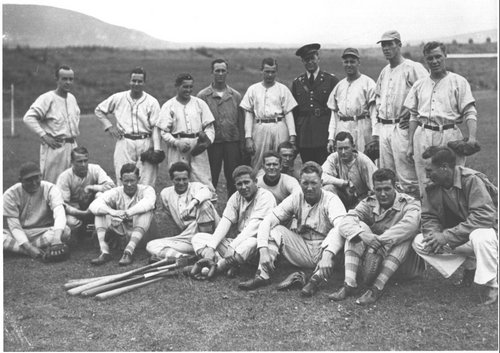 Neither team had uniforms, equipment was scarce, and a soccer field,
without a backstop or pitcher's mound, served as a diamond for the
afternoon. But baseball had arrived, and the troops welcomed it with
open arms. With the Army Air Force based at the Combat Crew
Replacement Unit at Greencastle in County Down and the Langford
Lodge Base Air Depot in Antrim, the Navy at the United States Naval
Operations Base (USNOB) in Londonderry, and the Army scattered
throughout the island, battalion-level baseball soon flourished on
the Emerald Isle.
Neither team had uniforms, equipment was scarce, and a soccer field,
without a backstop or pitcher's mound, served as a diamond for the
afternoon. But baseball had arrived, and the troops welcomed it with
open arms. With the Army Air Force based at the Combat Crew
Replacement Unit at Greencastle in County Down and the Langford
Lodge Base Air Depot in Antrim, the Navy at the United States Naval
Operations Base (USNOB) in Londonderry, and the Army scattered
throughout the island, battalion-level baseball soon flourished on
the Emerald Isle.
In July 1942, 34th Infantry and 1st Armored division all-stars teams
were selected to participate in Northern Ireland 's first officially
recognized baseball game of World War II. The last “official” game
had taken place 25 years earlier, on October 31, 1917 , when
Canadian and American troops put on an exhibition game for the local
people. Staged at Windsor Park , a soccer stadium in Belfast , and a
part of the Anglo-American Independence Day celebrations, the local
government and American military pulled out all the stops to put on
a July 4 spectacle.
Representing the 34th Infantry Division were the Midwest Giants
while the 1st Armored Division were represented by the Kentucky
Wildcats. It would appear that the Kentucky Wildcats nickname was
chosen because the original player line-up featured troops who were
predominantly from that state. Indeed, a pre-game press cutting
listed the southern-state players. However, for reasons unknown, but
probably because the originally selected players were with a
military unit that was otherwise indisposed, the Kentucky Wildcats
were represented by players mainly from New York and the east coast.
Midwest Giants (34 th Infantry Division)
Sgt Robert “Bob” Lange P Wilton Junction, IA Cleveland Indians'
organization
Pvt Vernon Kohler P Cincinnati, OH Cleveland Indians'
organization
Cpl Donald Shelton P Webster City, IA Pittsburgh Pirates'
organization
Pfc Orlando Langenfeld C Earling, IA Earling Independents semi-pro
Pvt John Hetcher C Yonkers , NY
Pvt Harold Flood 1B Cedar Rapids , IA
Sgt Erwin “Ed” Gangnath 1B Minneapolis , MN
Pvt
Victor Saltzgaver 2B Kansas City , MO
Pvt Lester Zabel 2B Davenport , IA Eldridge Merchants semi-pro
Pvt Daniel Leninger 3B Minneapolis , MN
Pvt Richard Olliges 3B St Louis , MO Emmett Athletic Club
Pvt
George Zwilling SS Cincinnati , OH Minor Leaguer
Sgt George Luke SS Dubuque , IA
Pvt Francis Tofanelli LF Davenport , IA St Ambrose University
Pvt Wayne Gaddis LF Waterloo , IA
Pvt Edward “Red” Orgell CF Eldora, IA
Sgt Robert Burns CF LeMars, IA
Pvt John Rooney RF Elgin , IA
Pvt Leo Robinson RF Harper's Ferry, IA Waukon Junior College
Kentucky Wildcats (1 st Armored Division)
Pvt Troy Needham P Scranton , AR Boston Red Sox organization
Gordon C
Pvt Paul Dowd 1B Livingston , NJ
Cpl Ed Hector 2B Orange , NJ
Pvt John Kratochwil 3B Long Island , NY Long Island semi-pro
Pvt Tom Cassidy SS New York , NY
Frazier LF
Pvt Sheldon Bowen CF Harrisville, NY Harrisville semi-pro
Sgt Laurence Crusie RF Covington , KY
Andriola PH
The Giants' line-up included Cleveland minor league pitcher Bob
Lange and another fellow Indians' farm system hurler, Private Vernon
Kohler. Kohler had an exceptional season with the Flint Arrows in
the Michigan State League in 1940, with an 18-5 won-loss record that
earned him a trip to spring training with the Indians in 1941.
Catcher, Sergeant Orlando Langenfeld and second baseman Private
Lester Zabel were talented semi-pro players and home-run-hitting Leo
Robinson was in right field.
The Wildcats were relying on the pitching talents of Private Troy
Needham, a 29-year-old left-hander who had spent time in the Boston
Red Sox farm system; hard-hitting semi-pro third baseman John
Kratochwil; and Sheldon Bowen, a semi-pro center fielder and
lead-off hitter.
On a fine, clear afternoon, an enthusiastic crowd, including
Northern Ireland 's Governor General (the Duke and Duchess of
Abercorn), Prime Minister (John W Andrews) and members of the
Cabinet and Government.
Stars and Stripes July 11, 1942
GIANT SUBSTITUTES DEFEAT KENTUCKY WILDCATS, 3 TO 2
The first team couldn't do the job, so they sent in the subs. The
subs did it.
That's the story of the 3 to 2 victory the Mid-West Giants scored
over the Kentucky Wildcats in an Independence Day baseball game
played in Belfast before an enthusiastic, albeit somewhat
bewildered, crowd of more than 7,500 fans, most of them civilians
who had never before seen a sample of the great American National
Pastime.
The Giants were trailing by a 2 to 1 score, going into the last half
of the eighth inning. Then the new team, which had taken over at the
start of the seventh frame, took the situation into hand and blasted
across the tying and winning runs.
During the two hours and seven minutes which the game lasted, the
spectators were treated to a pitchers' battle, featured by some
spectacular (and some sloppy) fielding, and a bit of clever base
running.
It was John Kratochwil's double in the third inning, scoring Sheldon
Bowen, that opened the scoring for the Wildcats. Kratochwil also
scored that inning, but the Giants pulled a run back in the sixth
and added a further two runs in the bottom of the eighth to take a
3-2 lead. In the final inning, Giants' relief pitcher Corporal
Donald Shelton, a big, raw-boned high school star, pitching in
relief of Lange and Kohler, forced the first two batters to ground
out and then retired the third on an easy fly to the shortstop to
preserve the win.
There was no pitcher's mound at Windsor Park ; base runners had to
skillfully avoid colliding with a soccer goal post down the first
base line, and spectators gathered dangerously close to home plate,
oblivious to the possible danger they faced. But the game was a
success with both the public and military and paved the way for many
further exhibition games over the following years.
Leo Robinson later described the day in a letter to his parents.
[I] was given time off to play baseball in Belfast the 4th of July.
Had a very good time. Had a crowd of about 10,000 people. Even met
some royalty as the ball team met and shook hands with the Duke of
Abercorn. Had a great time after the game, signing autographs. Made
us feel as if we were somebody.
The Duke of Abercorn, who was to become a familiar sight at
exhibition baseball games, obviously enjoyed the festivities that
afternoon. One member of the Midwest Giants recalls, “The duke had a
few too many tipped cups of good old Irish brew and had to be
escorted from the stadium after the third inning looking a little
worse for wear!”
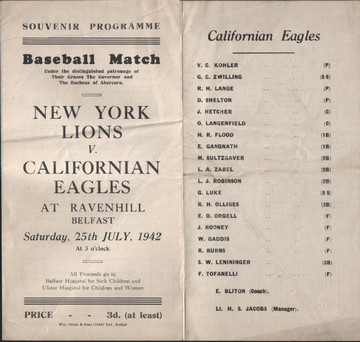 The players had another opportunity to feel important when the same
teams faced each other on July 25, in a benefit game for the Belfast
Hospital for Sick Children and the Ulster Hospital for Children and
Women. The 34 th Infantry Division, despite a wobbly pitching
performance by Vern Kohler, held on for a 9-6 win and a good sum of
money was raised.
The players had another opportunity to feel important when the same
teams faced each other on July 25, in a benefit game for the Belfast
Hospital for Sick Children and the Ulster Hospital for Children and
Women. The 34 th Infantry Division, despite a wobbly pitching
performance by Vern Kohler, held on for a 9-6 win and a good sum of
money was raised.
New York Lions
H W Martin P
A D Krulach C
E Hamilton 1B
E H Dettore 2B
W G Craman 3B
J Ranson SS
J H Sowa LF
R H Hensley CF
Reick RF
Commentary by Lt Col Maurice J Meyer
During the late summer of 1942, preparations for the Anglo-American
landings in North Africa saw an intensification of combat training
and the opportunity to stage division-level games became limited.
Yet baseball continued to thrive at the battalion level, fueled by
100,000 additional troops who arrived during August and September.
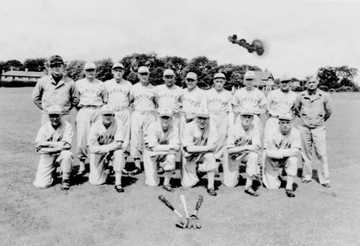 At the end of 1942, both divisions left Northern Ireland and were
soon in the heat of battle against Rommel's Afrika Korps in Tunisia
. For many troops of the 34th Infantry Division and 1st Armored
Division, the summer of 1942 held the last fond memories of the war.
Robert Burns,
Victor Saltzgaver,
George Zwilling and Don Shelton, all members of the Midwest
Giants baseball team, were killed in action. Leo Robinson suffered
serious shrapnel wounds to his legs that left him unable to run for
the rest of his life, and Orlando Langenfeld was badly wounded by
artillery shrapnel. Wildcats center fielder Sheldon Bowen was
wounded during an air attack. His left arm suffered shrapnel wounds
that required bone grafts, tendon transplants, and 16 months of
hospitalization. He never regained full use of his left arm
At the end of 1942, both divisions left Northern Ireland and were
soon in the heat of battle against Rommel's Afrika Korps in Tunisia
. For many troops of the 34th Infantry Division and 1st Armored
Division, the summer of 1942 held the last fond memories of the war.
Robert Burns,
Victor Saltzgaver,
George Zwilling and Don Shelton, all members of the Midwest
Giants baseball team, were killed in action. Leo Robinson suffered
serious shrapnel wounds to his legs that left him unable to run for
the rest of his life, and Orlando Langenfeld was badly wounded by
artillery shrapnel. Wildcats center fielder Sheldon Bowen was
wounded during an air attack. His left arm suffered shrapnel wounds
that required bone grafts, tendon transplants, and 16 months of
hospitalization. He never regained full use of his left arm
Despite the exodus of two complete divisions, American servicemen
continued to arrive in Northern Ireland towards the end of 1942 and
early 1943. A 12-team league based in Belfast staged its opening day
at Ravenhill Rugby Grounds on May 22, 1943. Captain Frank B Williss,
US Army special service officer and chairman of the league, had
arranged an elaborate day that included a military parade, but not
everything went according to plan. The US Army Quartermaster
Agitators were leading the Medical Corps Pill Rollers, 4-3, after
six innings, when the rapidly darkening skies produced a torrential
downpour that put an abrupt end to all activities. The notoriously
damp weather was something the Americans would become all too
familiar with. As one GI quipped, “If you can see the Mountains of Mourne, it's going to rain and if you can't see them, it's already
raining!”
The pitching ace of 1943 was 26-year-old Ed Behnen, a left-hander
with the US Army Headquarters. Behnen, from East St Louis , Illinois
, who pitched for Grand Forks in the Northern League in 1940. Behnen
hurled a no-hitter in late May, and then set a league record the
following month with 18 strikeouts in a single game.
The US Navy base at Londonderry was constantly expanding as it
became the coordination center for the war against the German
U-boats, and in addition to having a team in the Belfast league; it
operated its own league during the summer months with teams
representing the Navy, Sea Bees, Naval Hospital and Marines. It was
the Beech Hill Marine Corps detachment that clinched the Naval
Operations Base (NOB) five-game playoff series in September.
First-Sergeant Bill Robinson managed the Marines, aided by Robert
“Red” Kimball, a pre-war semi-pro pitcher with Garco of Charleston,
South Carolina and the Marion Swamp Foxes from North Carolina , and
Charles Ziober, formerly with the Newark Bears, provided offensive
punch.
In 1944, the American presence in Northern Ireland rapidly declined
with the Allied advance into mainland Europe . However, the Navy
operated a successful season that opened May 18. It was the Beech
Hill Marines, 1943 NOB champions that dominated the season. They
crushed the Lisahally Supply team, 16-0, on opening day and went on
to clinch their second league title.
By the end of 1944, only 2,000 American troops remained in Northern
Ireland . The American occupation had come to a close, and although
baseball rapidly became a distant memory for most Irish folk,
veterans like Orlando Langenfeld hold warm recollections. “I have
many fond memories of baseball over in Northern Ireland ,” he
recalls. “The practices and games provided a welcome respite from
the training and monotony of army life, while our friendly rivalry
always made the games interesting.”